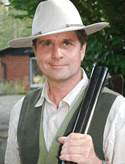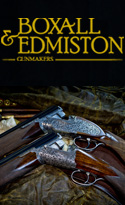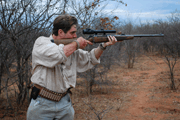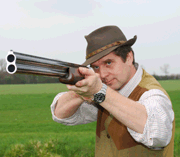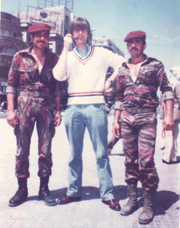A History of Repeaters
Pumps
The first successful pump gun—and the one which established the magazine-below-the-barrel and reciprocating forend configuration which has since become so familiar—was the six shot Spencer [It was not, of course, the first gun to use a tubular magazine under the barrel. The first patent for such a device was awarded to the American Walter Hunt in 1847.] The Spencer was the work of collaboration between Christopher Spencer of Spencer rifle fame and the no less gifted inventor, Sylvester Roper who had developed a revolving shotgun some twenty years earlier (which included within its specification a detachable choke device much like a modern competition gun).
The pair had developed a breech-loading revolving shotgun together in the 1860s and had been working on prototypes of slide action shotguns and rifles since about 1880. They were awarded a joint patent in 1882, a company was formed the following year and production of a shotgun commenced in 1884. A basic “Grade C” model with laminated steel barrel was advertised at $60. The “Grade B” with “Damascus Barrel” and engraving was $80, and the deluxe Grade A with “Italian Walnut” stock, “Turkish Damascus Barrel” and extra engraving $100.
The Spencer gun, which was finely made in all grades, incorporated a breechblock which pivoted up and down something like the Martini Henry single shot rifle - although the range of movement extended beyond the action body - rather than moving back and forth in the fashion of a modern pump action gun. The block had a trough in its top like the Martini but the was hollowed at the bottom so that a fresh cartridge might be fed into its recess from the spring-loaded tubular magazine. Sliding the forend back dropped the breech block and extracted the cartridge in the chamber and placed it on the trough, as the slide came right back, the block sprang up, hurled the spent cartridge up and brought the fresh cartridge held in the recess into alignment with the chamber mouth. The forward stroke put the fresh cartridge in the chamber and locked the action. It was certainly strong, effective and influential (the Winchester 1893, though it dispensed with the tipping breechblock had a carrier which operated vertically). The Spencer, moreover, had no external hammer and introduced the idea of loading the spiral sprung magazine from the bottom of the receiver in the modern manner unlike previous guns equipped with tubular magazines.
Annie Oakley is reputed to have used a Spencer in her famous shooting act. Her friend, H.A.A.Thorn (better known by his adopted name of Charles Lancaster) was sufficiently impressed with the gun that he imported 70 Spencers to England and fitted them with his own Damascus barrels and straight-hand or semi-pistol stocks. In an age before an anti-repeater prejudice had established itself in England, Basil Tozer (a.k.a 20 Bore) even wrote in his Hints on Shooting, a book of 1887: “On the whole…a repeating shotgun is preferable when battue shooting or driving, or in what is commonly known as a ‘warm corner’…To the Spencer gun we would give the priority; it is light for a repeater, weighing but 7 ¾ lbs., and in this gun also the mechanism of both lock and magazine is remarkably simple…it handles far more pleasantly than any repeating gun we know of. In a hot corner, with a couple of such guns, nothing more could be desired.” [ Page 6, Practical Hints on Shooting, Kegan Paul, Trench and Co., London, 1887.]
In spite of such glowing endorsements, the Spencer did not impress the British shooting public and was only moderately successful in the United States. The Spencer Arms Company went bankrupt in 1889, and manufacture was taken over by Francis Bannerman, a dealer in “military goods”, and continued until about 1902. This did not prove an altogether happy experience for Bannerman, but we may note with interest (and some caution) his firm’s manual for the Model 1900 (a gun barely different from the original Spencer): “For indoor practice we would suggest loading the gun with empty shells, caps only. Place six pieces of lighted candle three feet from the muzzle of the gun - aim - fire - and if you aim right the light will be blown out - then move the slide handle back full extent, then forward - aim - pull the trigger and repeat the operations until shells are discharged - Go slowly at first until you get the three movements - One, Backward - Two, Forward - Three, pull trigger. These movements can be made with such rapidity that all six shots can easily be fired in three seconds.”[as reproduced on page 285 of Roy. M. Marcot’s Spencer Repeating Firearms, Northwood Heritage Press, Irvine California, 1983.] This is not quite the method one would recommend today for learning how to cycle a pump. ‘Primer practice’ - which has been advocated by others - creates an obvious potential for disaster in that fully loaded cartridges may be mistaken for the practice ones (readers are not advised to try it).
Andrew Burgess—who can lay some claim to developing the pump action (or as he rather oddly called it “haveness”) before Spencer and Roper—also invented an ingenious sliding-pistol-grip pump action. This was first marketed in the early 1890’s, and appears from all accounts to have been just as fast firing as the Spencer, if ultimately less imitated. An advertisement of 1894 noting: “Double Hits in one-eighth second. Three Hits in one second, Six Hits in less than three seconds”. The gun came about, because Roper had been forced to abandon his sliding forend design because it infringed a catch-all Roper patent for sliding firearms (which itself may have infringed his own earlier patent, but regarding which he had instituted no infringement proceedings to his later cost). The Burgess gun, which held six cartridges in a tubular magazine, was available in sporting form and as an unusual (at the time, revolutionary) folding model designed for law enforcement.
The Burgess “folding riot gun” could be carried in a special holster under the coat and rapidly deployed in rather the same way as close protection officers now use machine pistols. Legend has it that a flamboyant Burgess salesman arranged an appointment with Theodore Roosevelt, then Police Commissioner of New York City (and later to become 26th President of the United States). During the interview, without forewarning, he whipped the gun out from under his coat, slammed it closed and blasted through a magazine of blanks. TR was the sort of man to enjoy a bit of showmanship. In any event, he was sufficiently impressed to order 100 for the prison service. The patents and tooling for the Burgess gun were sold to Winchester in 1899, but they never put it back into production.
No history of repeating shotguns would be complete without reference to John Moses Browning. He invented the excellent 1887 Winchester lever action shotgun and came up with a number of improved pump action designs during the middle and late 1880’s (before coming up with his classic Auto 5 design and taking a boat to Belgium). Browning sold his early pump action designs to Winchester, but none was actually manufactured until the appearance of the Model 1893. Clearly influenced by the Spencer discussed last week, this was an excellent, solid-frame, fixed-barrel design which offered a six shots (five plus one) in a slick and robust slide action. The gun was launched in the June 1893 catalogue with the following description: “The gun is operated by a sliding forearm below the barrel. It is locked by the closing motion and can be unlocked only by pushing forward the firing pin, which may be done by the hammer or by the finger. When the hammer is down, the backward and forward motion of the sliding forearm unlocks and opens the breech block, ejects the cartridge or fired shell and replaces it with a fresh cartridge.”
The gun had breechblock moving horizontally with an extractor attached, the carrier, however, moved vertically. A contemporary advertisement in Captain Money’s book Pigeon Shooting noted: “The Winchester Model 1893 Shot Gun is the BEST and MOST RELIABLE GUN for Trap Shooting as well as All-Around Shooting. Is proven by its popularity among the most successful shooters.”[see advertising appendices to Pigeon Shooting by Blue Rock as reprinted by Gunnerman Press, Auburn Hills, Michigan, 198.]
The trend-setting new gun led Winchester into litigation, however. Francis Bannerman, who had acquired the rights to manufacture the Spencer gun, and held the rights to a number of Roper and Roper-Spencer patents, claimed infringement and sued. The battle was long and acrimonious. Bannerman threatened to extend his action against all those selling or even using Winchester guns infringing his patents. Winchester responded by guaranteeing indemnity to their clients and sending agents abroad to trawl through European patents. Finally, they were able to prove that at least three sliding action gun designs had predated those to which Bannerman claimed patent rights. Bannerman’s lawyers claimed the guns were all unworkable, but, unbeknown to them, Winchester engineers had acquired a manufactured specimen of one and made working models of the others. In what must have been a moment of high drama, these were produced in court when counsel for Bannerman suggested the designs were not practical. Winchester won the case in 1897 and won again at appeal in 1900 (Bannerman never forgot or forgave). Throughout these difficulties, the excellent Winchester 93 remained in production and evolved into the even better Model 1897 - a classic of gun design. Its model designation would appear to a statement of the firm’s legal triumph.
The new model had a strengthened and lengthened receiver (to accommodate the then new 2 3/4” smokeless shell - the 93 had been designed for the old 2 5/8” black powder cartridge. In addition, the 97 offered an inertia slide lock (an important safety device, which prevented accidents in the days when cartridges were prone to hangfire), side ejection and, from 1898, a takedown feature based on an interrupted screw system. The standard gun was $25 and the takedown version, $27. They sold like hot cakes. If Marlin had not introduced a visible hammer, six-shot (five plus one), pump in 1898 (the Model 1898) Winchester would have had a virtual monopoly. The 1897 still became one of the most successful sporting guns ever made (remaining in production until 1957 with a production run of a million units). And, as well as being a favourite with shooting sportsmen, became popular with the police and the military. Winchester were the first firm, to really exploit this market. A short barrelled “trench gun” variant of the ’97 with a distinctive perforated hand-guard around the mid-section of the 20” barrel was issued to U.S. troops in the First World War. It was a deadly weapon at close quarters and similar guns saw service in WW II, Korea and Vietnam.
Internal hammers
John Moses Browning was also responsible for the perfection of the hammerless system in pump actions. In 1903, he sold the patents and manufacturing rights for a gun which would become the Stevens Model 520 (later improved as the 620). It was not his prettiest creation, but it combined a hammerless design with a receiver which neatly enclosed all the working parts. This was the way of the future. Remington introduced their Model 10 hammerless design in 1907 (designed by J. D.Petersen and patented in 1903). The first streamlined slide action, it was a well made takedown design with a five-shot magazine capacity; it remained in production for nearly 25 years. Historically it is significant because it ejected and loaded from the bottom, a feature copied in the next Remington, the Browning-designed, Model 17 20-bore (later manufactured as a 12 and 16-bore by Ithaca as the now famous Model 37). The Model 17, still much admired, also introduced a new takedown system in which the gun split into two sections on primary disassembly: the almost-bare barrel on the one hand and the receiver assembly with stock, magazine tube and fore-end attached, on the other. Earlier repeaters kept the magazine tube and barrel together on takedown.
John Moses Browning was not directly responsible for the beautifully streamlined, hammerless, side-ejecting, Winchester Model 12, but the earlier JMB designs and the Remington Model 10 must have been a significant influence on the design team for the Model 12, which was led by Thomas Crossley Johnson, a Winchester employee. The Model 12 is, arguably, the finest pump action ever made (although my own belief is that it would be even better with double action bars). It is, undeniably, one of the prettiest. The guns are not only long lived, but reliable (save for an occasional broken firing pin). Many Model 12’s are still in use; they are popular as field guns and for Trap shooting (although in this discipline, their numbers are declining). David Butler, who worked as a senior engineer for Winchester, notes: “Model 12 shotguns were designed almost without regard to cost. Nickel-steel barrels were fitted and chrome-molybdenum alloys were used in receivers and interior components. This meant that the gun was always very high priced in relation to other slide action shotguns. It also meant that the guns were virtually indestructible and, if given adequate care and cleaning, would last several lifetimes.” [The American Shotgun, p113.] The Model 12 has inspired many more recent designs. Like the Model 1897, it was made in enormous quantities with more than two million produced in total.


